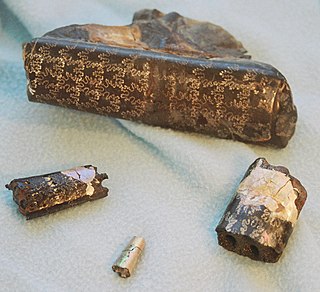
Baculites is an extinct genus of heteromorph ammonite cephalopods with almost straight shells. The genus, which lived worldwide throughout most of the Late Cretaceous, and which briefly survived the K-Pg mass extinction event, was named by Lamarck in 1799.

Scaphites is a genus of heteromorph ammonites belonging to the Scaphitidae family. They were a widespread genus that thrived during the Late Cretaceous period.

The Turonian is, in the ICS' geologic timescale, the second age in the Late Cretaceous Epoch, or a stage in the Upper Cretaceous Series. It spans the time between 93.9 ± 0.8 Ma and 89.8 ± 1 Ma. The Turonian is preceded by the Cenomanian Stage and underlies the Coniacian Stage.
Kamerunoceras is an extinct cephalopod genus belonging to the ammonite family Acanthoceratidae, found in Upper Cretaceous formations of Africa, Europe and North and South America.

Placenticeras is a genus of ammonites from the Late Cretaceous. Its fossils have been found in Asia, Europe, North and South America.

The Tres Hermanos Formation is a geologic formation in central and west-central New Mexico. It contains fossils characteristic of the Turonian Age of the late Cretaceous.
The genus Cibolaites is a strongly ribbed and nodose ammonoid cephalopod from the middle Cretaceous of western New Mexico, included in the taxonomic family Collignoniceratidae. A single species Cibolaites molenaari is known.

Collignociceras is a strongly ribbed and tuberculate, evolute ammonite from the Turonian of the western U.S. and Europe belonging to the ammonitid family Collignoniceratidae. The genus is named after the French paleontologist Maurice Collignon. The type is Collignoniceras woollgari, named by Mantell in 1822 for specimens from Sussex, England.
Neoptychites is an extinct ammonoid cephalopod genus from the Turonian stage of the Upper Cretaceous, with a worldwide distribution.

Acanthoceratoidea, formerly Acanthocerataceae, is a superfamily of Upper Cretaceous ammonoid cephalopods belonging to the order Ammonitida, and comprising some 10 or so families.

Mammites is a Late Cretaceous ammonite genus included in the acanthoceratoidean family, Acanthoceratidae, and the type genus for the subfamily Mammitinae. Mammites was named by Laube and Bruder in 1887.

Calycoceras is an extinct genus of cephalopods belonging to the subclass Ammonoidea and family Acanthoceratidae that lived during the Cenomanian stage of the Late Cretaceous, 100-94 Mya. Their shells had ornate ribs.

Kossmaticeras is an extinct ammonoid genus belonging to the desmoceratacean family Kossmaticeratidae. Species in this genus were fast-moving nektonic carnivores. They lived during the Late Cretaceous, from upper Turonian to upper Maastrichtian age. The type species of the genus is Ammonites theobaldianus.

The Acanthoceratinae comprise a subfamily of ammonoid cephalopods that lived during the Late Cretaceous from the latter early Cenomanian to the late Turonian
Cunningtoniceras is a stocky acanthoceratid ammonite from the upper Cenomanian stage of the late Cretaceous of the western U.S., found e.g. in Arizona and New Mexico.
Neocardioceras is a genus of evolute acanthoceratid ammonites from the uppermost Cenomanian, Upper Cretaceous, of Europe, western U.S. and Brazil.
Quitmaniceras is a genus of small, compressed, fairly evolute ammonites from the lower Turonian of Grant County, New Mexico and Trans-Pecos Texas, included in the subfamily Acanthoceratinae. The shell has a carinate venter in juveniles and one that is arched in adults, usually with a raised siphonal line,(siphonal referring to the marginal siphuncle). Ribs are very weak to moderately strong, flexious, typically sloping forward toward the rim, bending further forward at the outer shoulder.

Scaphitidae is a family of extinct cephalopods belonging to the family of heteromorph ammonites. There is a possible fossil record of them being the last ammonites with fossils dating to the Danian of the Paleocene in Denmark, The Netherlands, The US and Turkmenistan.

Gaudryceras is an ammonite genus belonging to the family Gaudryceratidae.

Diplomoceratidae is a family of ammonites included in the order Ammonitida. Fossils of species within this genus have been found in the Cretaceous sediments. Studies of Diplomoceras suggest that members of this family could reach lifespans of over 200 years.














